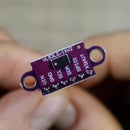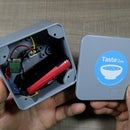Introduction: DIY King Size Bed
Hi Everyone,
In this Instructable, I will show you how I built my new king size bed with 3x3cm square tubing steel for the base and doubled up melamine for the sides.
The final price for the bed was around $350, including the mattress, which is about half of what we were to pay for a similar bed in store.
This project is perfect if you want to practice welding and it took me around 3 days in total to make it.
If you are more into video instructions, you can watch the entire making process below:
If you want to replicate my exact dimension, you can download the Sketchup model from here.
Supplies
Tools used in this video:
- 140A Inverter welder - https://s.click.aliexpress.com/e/_AnJniC
- Corded angle grinder - https://s.click.aliexpress.com/e/_A5GBlq
- Corded Drill - https://s.click.aliexpress.com/e/_AKcq3I
- Cordless drill - https://s.click.aliexpress.com/e/_A2Di68
- Angle grinder cut off disks - https://s.click.aliexpress.com/e/_9jy6Wy
- Angle grinder flap disks - https://s.click.aliexpress.com/e/_ACY2l6
- Metal drill bits - https://s.click.aliexpress.com/e/_9uelPa
- Drill stand - https://s.click.aliexpress.com/e/_9urhP6
- M6 Bolts - https://s.click.aliexpress.com/e/_9IA8V2
- M3.5 16mm chipboard screws - https://s.click.aliexpress.com/e/_9gLkt2
- Metalic markers - https://s.click.aliexpress.com/e/_A2jiA4
- Quick release clamps - https://s.click.aliexpress.com/e/_AaYTu8
- Welding magnets - https://s.click.aliexpress.com/e/_AlvkEU
Alternative links on Banggood:
- 140A Inverter welder - https://www.banggood.com/custlink/KGGRieJpKg
- Angle grinder - https://www.banggood.com/custlink/mvvYIBWJdh
- Cordless drill - https://www.banggood.com/custlink/mKKR9iOzmG
- Angle grinder flap disks - https://www.banggood.com/custlink/3mKRSeprhK
- Metal drill bits - https://www.banggood.com/custlink/KvKEIgrpdp
- Drill stand - https://www.banggood.com/custlink/K3DYi4cC3A
- Quick release clamps - https://www.banggood.com/custlink/GDDE9gprE6
- Welding magnets - https://www.banggood.com/custlink/DvDdZBpJdb
Step 1: Prepare the Pipes for the Short Supports
I bought the metal pipes from a local warehouse and to be able to transport the pipes easily, they cut them into smaller pieces for about 2 of the smaller support pieces in each pipe.
To make the individual supports, I first wiped off the protective oil coat, marked the needed dimensions and I've used a cut-off disk on my angle grinder to cut at the right dimensions.
I've cleaned all of the edges on my belt sander, and once I had all of the pieces, I've clamped them together and used a wire wheel on my drill to clean them up for welding.
Step 2: Weld the End Brackets to the Short Supports
I needed an easy way of attaching the multiple pieces together, as well as attaching the support base to the frame so I bought some mounting brackets that had multiple holes in them.
They have one bigger and 4 smaller holes on each side and were perfect for the job as I can use the bigger hole for the M6 bolts to hold the base and the smaller holes to mount the base to the outside frame.
Unfortunately, some of the brackets were zink plated so while welding them, I made sure to ventilate my workshop as best as I could and to keep my head away from the smoke generated.
Step 3: Prepare the Long Support Pipes
The long support pieces are exactly the same as the short ones but they span the entire inside width of the bed.
I first cut them to length, clean up the ends, and welded a bracket in the same way as I did on the short supports.
Step 4: Drill Mounting Holes
To be able to mount the base together, I marked and drill holes in the long support pieces.
These holes are made in the center of all of the three supports and at two thirds on the front and back support as I had them in my drawing.
I made this to minimize the material needed while still evenly distributing the weight.
All of the holes were first drilled with a 3mm drill bit and then enlarged to 6.5mm.
Step 5: Prepare the Support Legs
To transfer the weight to the floor, I'll add two legs on each of the long support pieces.
These are made by first cutting them to length, cleaning up the edges, and cleaning them up with a wire wheel.
Step 6: Weld the Legs to the Long Support Pipes
The legs are mounted at one-third of the length from each side.
I first placed them at the designated place, and hold them with the welding magnets while tack welding at each corner. Once the leg was tacked into place, I welded it securely from all sides.
Step 7: Add Paint
To protect the metal from rusting, I've first added a coat of primer to all of the parts and then a coat of paint.
Step 8: Add End Caps to the Legs
Since the legs will be touching the laminate flooring that I have, I plugged the ends of them with plastic end caps. This way, they will not damage the floor.
Step 9: Attach Sides to the Headboard
The headboard and the bedsides are made out of 16mm melamine. To gain in strength, the sides and the front pieces are doubled-up to 32mm, and ABS edge banding is applied to both pieces.
To attach the sides to the headboard, I've used two parts angle brackets that can be later removed if I ever need to disassemble and move the bed.
Since I did not have any mounting instructions for them, I placed the side on top of the headboard, added the bracket in place, where it was supposed to go, and marked out the location of the holes.
I then pre-drilled the mounting holes and secured the brackets with 16mm chipboard screws.
Step 10: Prepare and Attach the Front Melamine Legs
The metal base legs are about 60cm inward from the edges and because of that, I was afraid that the bed might want to tip to a side if someone is on the edge.
To prevent this, I made two corners out of melamine pieces that I secured to the end of the sides while they were still upright.
Once I tip over the frame, the sides will sit on these legs at the front at the same height as on the back.
Step 11: Assemble the Metal Support Base
I now tipped the bed to its proper orientation and I've started to assemble the different pieces for the support base.
For this, I used M6 bolts and nuts and I also added a washer on each side of the bolt.
At first I only hand tighten them and then I went over all of them with a wrench to align everything and secure them in place.
Step 12: Connect the Frame and Base
Before I attached the frame to the base of the bed, I first checked the alignment of the sides to make sure that they are square to the headboard and that they align with the mounting plates on the base.
Once they did, I first mount the front frame piece to the melamine legs on the front and I've then used 16mm chipboard screws to connect the metal base to the side frame through the mounting plates on the end.
Step 13: Add the Mattress Support and Mattress
Before I've added the mattress, I've added two boards of particle board on top of the frame so the mattress can be supported on a greater surface.
These boards are smaller than the inside of the bed and additionally, I've made 6 holes into each so air can flow through them and extract any moisture that might get into the mattress.
On the long run, this should prevent any mold and keep the mattress nice and dry.
Step 14: Enjoy
Once we put the mattress in, my kids immediately stormed the bed and started jumping on it to test out its strength.
Since the base is more than strong enough to support them, the bed did not even move, thus it should be very durable and last a long time.
If for some reason there is some damage to the melamine on the outside, the entire frame can be replaced for about $100 later on and will practically make a "new" bed while still keeping the original base.
If you liked this project, you can subscribe to my YouTube channel or check my other Instructables and I'm sure that you'll find more of them to love.
Cheers and thanks for reading.

Participated in the
Self-Care Challenge













